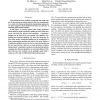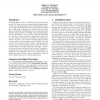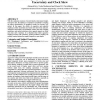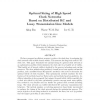97
Voted
ASPDAC
2012
ACM
13 years 8 months ago
2012
ACM
— In this paper, we present an obstacle-aware clock tree synthesis method for through-silicon-via (TSV)-based 3D ICs. A unique aspect of this problem lies in the fact that variou...
121
click to vote
PAM
2011
Springer
14 years 3 months ago
2011
Springer
In this paper, we characterize, quantify, and correct timing errors introduced into network flow data by collection and export via Cisco NetFlow version 9. We find that while som...
106
click to vote
ASPDAC
2008
ACM
15 years 2 months ago
2008
ACM
This paper investigates methods for minimizing the impact of process variation on clock skew using buffer and wire sizing. While most papers on clock trees ignore data-path circuit...
117
click to vote
USS
2008
15 years 2 months ago
2008
The Tor anonymisation network allows services, such as web servers, to be operated under a pseudonym. In previous work Murdoch described a novel attack to reveal such hidden servi...
ASPDAC
2001
ACM
15 years 4 months ago
2001
ACM
Clock-tuning has been classified as important but tough tasks due to the non-convex nature caused by the skew requirements. As a result, all existing mathematical programming appr...
123
Voted
CCS
2006
ACM
15 years 4 months ago
2006
ACM
Location-hidden services, as offered by anonymity systems such as Tor, allow servers to be operated under a pseudonym. As Tor is an overlay network, servers hosting hidden service...
111
click to vote
DAC
2010
ACM
15 years 4 months ago
2010
ACM
Clock skew optimization continues to be an important concern in circuit designs. To overcome the influence caused by PVT variations, the automatic skew synchronization scheme can ...
DAC
2007
ACM
15 years 4 months ago
2007
ACM
With the continuous increase of circuit density, interconnect length, and aspect ratio, the influence of capacitive and inductive coupling on timing characteristics of integrated ...
ASPDAC
2007
ACM
15 years 4 months ago
2007
ACM
Abstract-- Nanometer VLSI systems demand robust clock distribution network design for increased process and operating condition variabilities. In this paper, we propose minimum clo...
110
click to vote
ICCAD
1993
IEEE
15 years 4 months ago
1993
IEEE
We have proposed an e cient measure to reduce the clock skew by assigning the clock network with variable branch widths. This measure has long been used for \H" clock tree. T...




